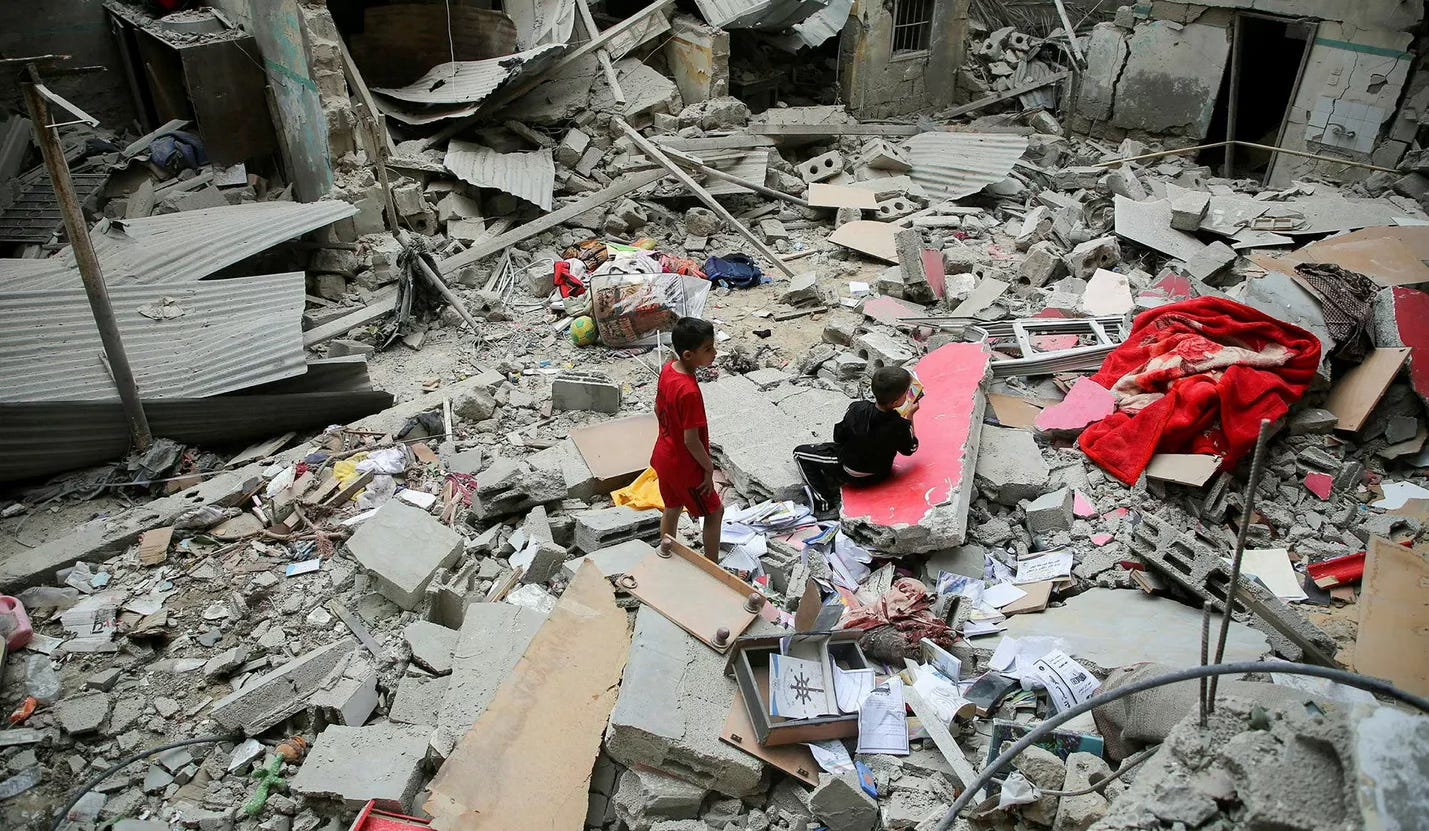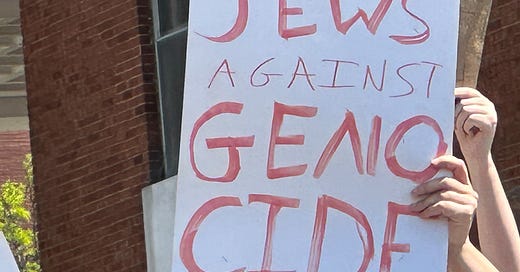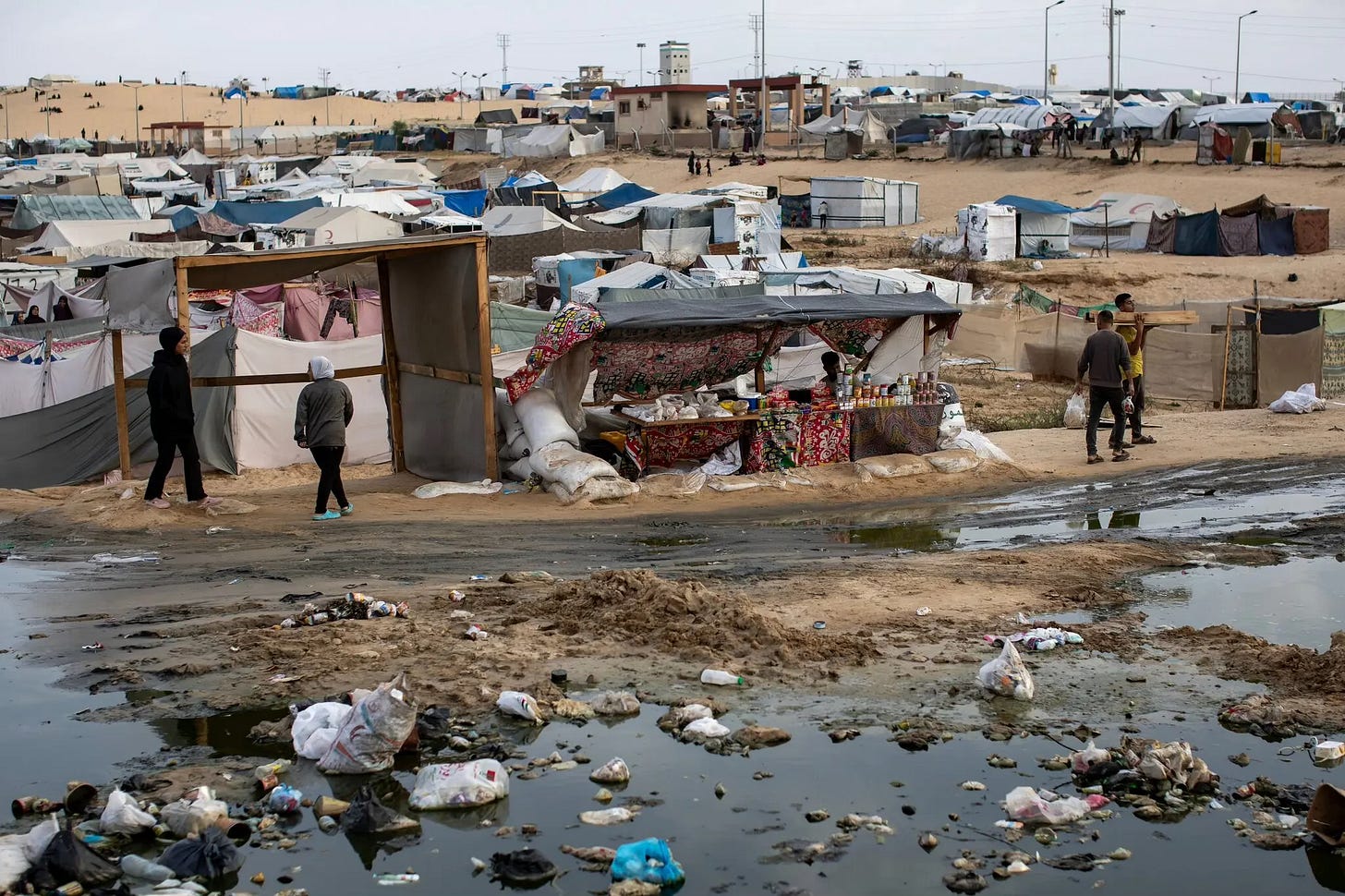1.
Tents now occupy Voorhees Mall at the center of Rutgers University’s College Avenue campus, with students pressing their demands for justice for Palestinians and university divestment from companies doing business with Israel.
The encampment is one of dozens around the country, many of which have been met with police crackdowns and threatened suspensions of students. It is too early to know how the Rutgers administration will respond — I write this at the very early stages of the action — but it is clear we have reached a tipping point for this pointless and murderous war.
We are approaching 35,000 dead in Gaza, killed by the Israeli Defense Forces in what some call a genocide. The word is contested, but the unremitting assault by the IDF has exceeded all logical proportions. If Israel’s actions in the days following the Oct. 7 attack by Hamas could be seen as defensive — as the Netanyahu government and Israel’s supporters argue — the nearly seven months of total assault, which has leveled much of Gaza and has its population on the precipice of famine has left that thin rationale in tatters.
The quick spread of these encampments are evidence of a refusal to tolerate the kind of brutality being imposed on innocent civilians by an Israeli government — with material support from the American government. The 60, 80, 100 encampments have a singular message: Not in our name.
What we are witnessing in Gaza, after all, is a series of war crimes, that build on a history of repression. I agree that the Oct. 7 attack by Hamas also constituted a war crime, but we are seven months in and it is disingenuous for us to keep pointing to the 1,200 dead Israelis as a justification for the continued slaughter in Gaza, which I would call an ethnic cleansing, if not a full-on genocide.
Understanding the debates over what is happening in Israel and Gaza and on our campuses, which are linked, requires us to understand how divorced we have become from notions of evidence how much we have given in to our own biases. We have lost any sense of intellectual humility, and would rather engage in shouting matches and rely on absurd conspiracies (someone must be funding these kids? Who bought the tents?) to justify our preconceived beliefs.
2.
Images tell a story — images of destruction and violence and death — and were among the evidence that shook me from a kind of intellectual paralysis tied to personal history. I have long been critical of Israel’s actions, its use of historical Jewish tropes of victimhood to justify its bullying behavior in the Occupied Territories. But I was ambivalent about Israel itself, was wed to what I’d learned in Hebrew school and from my Jewish community about the Jewish state and Zionism. I wasn’t a Zionist, but I did accept the idea of a Jewish state. Israel’s behavior was a reaction to its neighbors, and a function of its rightwing governing coalition. It was excessive but understandable. This is what I was taught, what so many Jews of my age and older were taught, and, while it was at odds with all of the other core beliefs I held, I had trouble fully breaking from this way of thinking.
I was at a wedding on Oct. 7 when the news of the Hamas attack broke. I was receiving updates on my phone from various sources — The New York Times, The Washington Post, the Associated Press — but there was not much clarity. It was numbing and I was unsure how to react. I wrote an essay outlining my initial thoughts. My goal with that was to place Oct. 7 with context, as I understood it, while portraying the sense of ambivalence I was feeling.
The reactions were harsh. Zionist Jewish friends were aghast, seeking to educate me with a historical account that sounded suspiciously like the invented mythology of Leon Uris’ Exodus. The story they sought to tell begins in 1948, and it focuses on the armies of the various Arab nations. It presents the Jews in a Maccabean light, as a small band of fighters defending their small patch of land and their historical legacy. I recognized this narrative, and can place myself back in my Hebrew School classroom with Mr. Salas teaching us about Israel as we celebrated its 25 years as a state. The story was heroic and merged with Biblical and post-Biblical tales of Moses, David, the defense of the Temple, and the miracle of Hanukkah..
The story Jews of my generation — I am late baby-boomer — told ourselves was always more myth than fact, or at least stylized and decontextualized. Missing from this story was the history of European Colonialism and racism, the long existence of a people living in the region we now call Israel and Palestine, and the geo-politics of the Cold War. The story we tell ourselves elides one of the core tenets of Zionism, a reactive racism that erases Palestinians as a people and erects a dangerous nationalist argument that excuses Israel’s role as brutal military overlord in the West Bank and Gaza. These are the biases, at base, that animate much of American Jewry’s support for Israel’s violent imposition of control over Palestinians in the territories Israel has militarily overseen for decades, biases that causes Israel’s supporters and critics to look at the basic facts of the current war and the history of the region as if they are looking at completely different realities.

There is an image from early in the Israeli war on Gaza that still haunts me. It was in Jewish Currents, a young child with wide brown eyes staring into the camera lens. Orphaned. Probably too young to understand. Likely to grow up — if she is given the chance to grow up — thinking war is normal, that occupation is normal.
This photo helped clarify some things in my mind about how I feel about Israel, Gaza and the West Bank, and my relationship to a narrative that has been difficult to throw off — evidence, I think of Susan Sontag’s argument1 that our interpretations of images, of photos, stems from our existing beliefs and do not alter our thinking. We are not roused from our complacency, so much as confirmed in our bias.
Pictures of war, she writes in Regarding the Pain of Others, become generic examples of war’s brutality. Photos of victims — such as the child in Gaza — “are themselves a species of rhetoric. They reiterate. They simplify. They agitate. They create the illusion of consensus.” But in simplifying, they elide the politics. For the viewer, war is bad, except when it isn’t, and violence is to be denounced except when perpetrated by our allies.
What Sontag is saying may seem counterintuitive for some. When someone sees pictorial evidence of horrors, we assume they will recoil, that they will react in shock. The photo of the Palestinian orphan I mention above is a good example. Post it to Facebook and you are likely to get a diversity of opinion, some mirroring my anger or horror, some not. Some (like me) will blame the Israeli military and government — and the long-standing occupation — as I do; others will say Hamas is to blame. Her fate was sealed by the Oct. 7 attack, they will say, or by Hamas’ use of civilians as human shields.
3.
Images tell a story, as I said, and I think the photos from Gaza by news agencies like Associated Press, the AFP, and Reuters are important pieces of an evidentiary trail that those of us who live far from Israel and Gaza can use to help us understand what has been happening.

Haaretz, the liberal Israeli daily, ran a Reuters photo (Credit: Hatem Khaled) on April 27 that showed a pair of “Palestinian children inspect(ing) the site of an Israeli strike on a house” in Rafah.

On the same day, The Washington Post offered an aerial view of Khan Younis that shows a city in rubble and ash.
And in another photo published on April 27, this one in The New York Times, a sewage spill in a camp for the displaced in Rafah is foregrounded against a background of lean-tos and make-shift shelters similar to what I’ve seen in homeless encampments here. The contrast is unmistakable: These images are of the buildings where Gazans lived and worked, structures made uninhabitable by Israeli bombs, and of the structures in which Gazans live today.
Three photos among thousands taken since Oct. 7, all presenting the lived reality of those in the Gaza Strip, capturing the harsh reality of living under occupation and war. These photos can feel like what is often called “disaster porn,” a kind of voyeuristic gaze into tragedy often used to manipulate. The viewer reacts with a helpless sorrow or anger and then is asked for money. We see this from the ASPCA and the International Fellowship of Christians and Jews, which parades elderly Holocaust survivors in the Ukraine across our TV screens without a mention of the political causes of what is happening there.
“Photographs of an atrocity may give rise to opposing responses,” Sontag writes. “A call for peace. A cry for revenge. Or simply the bemused awareness, continually restocked by photographic information, that terrible things happen.”
Viewing photos of war — she is writing primarily about the Iraq War in this book — require an “ample reservoir of stoicism” or the viewer will collapse in an emotional heap. “(T)he pity and disgust that pictures” like these, or the specific ones from 20 years ago that she is directly commenting on, “should not distract you from asking what pictures, whose cruelties, whose deaths are not being shown.”
What is happening beyond the frame? And why the focus on what is being captured within the frame?
These are important questions, which generally are not being asked. On the pro-Israel side, for instance, we have tightened the metaphorical frame in a way that denies much of the history, that accepts only a small cache of “facts,” cherrypicked and arranged to present Israel as martyred nation, exceptional and heroic — like in the Bob Dylan song from Infidels, “Neighborhood Bully”2:
Well, the chances are against it and the odds are slim That he’ll live by the rules that the world makes for him ’Cause there’s a noose at his neck and a gun at his back And a license to kill him is given out to every maniac
Dylan’s lyric here has a starting point, a point of view, that governs how he analyzes the data, the stories he tells, and make clear that the title is ironic. The “neighborhood bully” is Israel, thinly veiled. The singer implies that the world sees this nation as a bully, but that the nickname is misplaced, that the “bully” is “outnumbered about a million to one,” with “no place to escape to, no place to run.” He wanders the world, a stateless being, “family scattered, his people hounded and torn.”
The neighborhood bully just lives to survive He’s criticized and condemned for being alive He’s not supposed to fight back, he’s supposed to have thick skin He’s supposed to lay down and die when his door is kicked in
The “bully” is a familiar type, a trope straight out of the Uris novel Exodus that would be familiar to — and resonate with — the mainstream of American Jewry at the time. The song starts from the same place where commentary from the ADL and other pro-Israeli Jewish groups begins — a starting point that governs what is seen and how it is seen, that sets the frame of the photo, and the parameters of the story.
These parameters are severely limiting, but not surprising, and, if we are to find ways to move forward on this issue, we have to acknowledge they exist —- just as these filters and frames govern discussion of Israel and Palestine from the pro-Palestinian point of view. It’s why the slogans chanted by students at rallies like the one I attended on April 29, which served as the kick off of the Rutgers encampment, seem to create controversy. Many Jews do hear them differently than Palestinians and their supporters, a fact that creates discomfort but in no way supports the contention that these slogans call for genocide. They are not. Israel’s assault on Gaza is, however, and the increasing number of dead and the destruction of Gaza offers proof — or would, if only we could shed the frames we use to constrain our viewpoints.
Sontag, Susan. Regarding the Pain of Others, Picador, 2003, ebook, https://books.apple.com/us/book/regarding-the-pain-of-others/id707372418.
Dylan, Bob. “Neighborhood Bully.” Infidels, BobDylan.com, 1983, https://www.bobdylan.com/songs/neighborhood-bully/. Dylan, Bob. “Neighborhood Bully.” YouTube,






